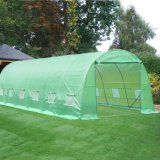Components of a Small Portable Greenhouse Garden
2024-06-21
A household small portable greenhouse garden is a convenient and versatile structure designed for cultivating plants, extending the growing season, and protecting delicate vegetation from adverse weather conditions. Here’s an overview of what it typically includes, its benefits, and considerations for setting up one:
Components of a Small Portable Greenhouse Garden:
1. Frame:
- Usually made of lightweight materials such as aluminum, steel, or PVC.
- Provides structural support and stability for the greenhouse.
2. Covering:
- Options include clear polyethylene (PE) or polyvinyl chloride (PVC) plastic film, or UV-resistant polycarbonate panels.
- Allows sunlight to penetrate while creating a greenhouse effect to trap heat.
3. Ventilation:
- Vents or windows to regulate airflow and temperature inside the greenhouse.
- Ensures proper ventilation to prevent overheating and humidity buildup.
4. Shelving and Benches:
- Interior shelves or benches for organizing plants and maximizing vertical growing space.
- Provides storage for gardening tools, pots, and supplies.
5. Accessories:
- Depending on the model and purpose, may include hooks for hanging plants, irrigation systems, and temperature or humidity monitors.
Benefits of a Small Portable Greenhouse Garden:
1. Extended Growing Season:
- Creates a microclimate that protects plants from frost and allows for earlier planting in the spring and later harvesting in the fall.
2. Protection from Weather and Pests:
- Shields plants from extreme weather conditions such as wind, rain, hail, and excessive sun exposure.
- Reduces the risk of pest infestations compared to open garden beds.
3. Controlled Environment:
- Allows control over temperature, humidity, and light levels, facilitating optimal growing conditions for a wide range of plants.
- Suitable for starting seeds, propagating cuttings, and nurturing tender plants.
4. Versatility and Mobility:
- Portable designs allow for easy relocation within the garden or backyard.
- Ideal for renters or homeowners with limited space who want the flexibility to move or adjust the greenhouse as needed.
5. Year-Round Use:
- With proper insulation and heating (if required), some portable greenhouses can be used throughout the year for continuous cultivation.
Considerations for Setting Up a Small Portable Greenhouse Garden:
1. Location:
- Choose a site with ample sunlight exposure (ideally south-facing) and good drainage for optimal plant growth.
- Ensure the area is level and stable to support the greenhouse frame.
2. Size and Capacity:
- Select a greenhouse size that accommodates the number of plants you intend to grow and fits within your available space.
- Consider height clearance for taller plants and space for walking and working inside.
3. Climate and Conditions:
- Evaluate local climate conditions and seasonal variations to determine the greenhouse’s insulation and ventilation needs.
- Prepare for temperature fluctuations and potential weather extremes by choosing appropriate covering materials.
4. Maintenance:
- Regularly monitor and maintain the greenhouse environment, including watering, ventilation, pest control, and cleaning.
- Check and repair any tears or damage to the covering material to maintain insulation and protection.
5. Budget and Quality:
- Balance cost considerations with quality and durability when choosing a portable greenhouse.
- Invest in a sturdy frame and reliable covering material that will withstand outdoor conditions and provide long-term use.
By setting up a small portable greenhouse garden, you can enjoy the benefits of year-round gardening, protect your plants from external elements, and create an ideal environment for healthy growth and cultivation. Whether for hobby gardening or supplementing your household’s fresh produce, a portable greenhouse offers flexibility and convenience in managing your garden space effectively.



